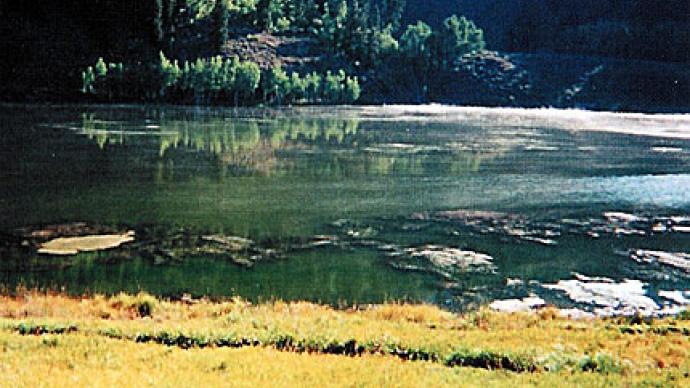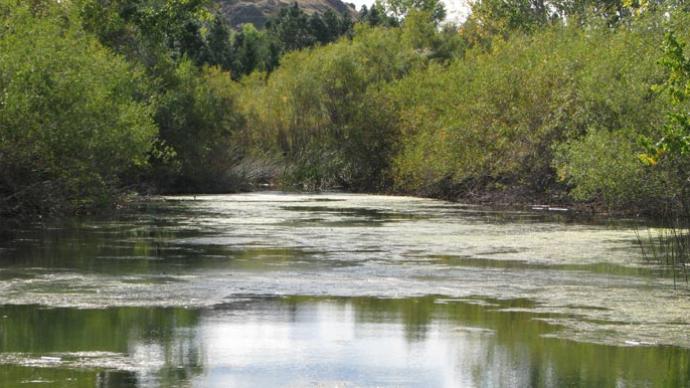
To fertilize, or not to fertilize? It's more than a Shakespearean question. If you're a long time Pond Boss reader, your head is probably spinning when it comes to the topic of fertilization. Read Mike Mitchell's article about algae this issue. In his world, fertilizing a pond Could be a hangin' offense. Same philosophy in northern ponds. Just ask Dr. Dave Willis in South Dakota or Mark Cornwell in upstate New York. They seize up when talking about fertilizing a pond. But, bring in Greg Grimes in Georgia, Norman Latona in Alabama and ask them. They believe fertilization is crucial to pond management.
What gives?
Simply speaking, introduction of nutrients has consequences. Understand those consequences. Properly applied into the water column, phosphorus based fertilizers promote the growth of microscopic plants and animals called "plankton." Plankton thrives in moderate to warm water temperatures. Plankton is important for two reasons. First, it's food in the primary, beginning stages of a food chain. Tiny, newly hatched fish have no energy stores shortly after hatching, so they must eat soon after absorbing their yolk sac. Tiny fish have tiny mouths and need tiny food. Plankton feeds insects and tiny fish, dramatically improving Survival rates of newly hatched fish. Second, plankton blooms minimize seriously clear water. Clear water allows sunlight penetration to the bottom, where noxious rooted aquatic plants gain an invasive foothold.
In areas of the United States most known for warm water, fertilization can be a great thing. Increased fish production and decreased vegetation, if your timing is right. (Timing is a big deal). Here's the warmwater down side. If you fertilize at the wrong time, let's say too early, while temps are still cool, you get no bloom, and fertilizer may be bound in soils. If you fertilize too late, you may be feeding unwanted rooted plants, rather than much needed plankton. In the warm south, measure visibility depth of your pond when water visibility is greater than three feet, consider fertilization.
Here's the catch. Fertilizer must be mixed into the water column. Don't just toss it in. Mix it in. Don't fertilize low alkalinity, acidic water. If you don't know your alkalinity, have it checked. Alkalinity less than 17 ppm normally won't allow a bloom. The clearer the water, the more fertilizer you need.
Here's a fundamental recommendation. Confirm with local biologists who know your water and soils. Water visibility greater than six feet, apply 3-4 gallons of 10-34-0 liquid fertilizer. That extrapolates to 10-15 pounds of phosphorus per surface acre of crystal clear water. Granular pond fertilizers are different. They claim to have better solubility, so they recommend lower doses. If visibility is four to six feet, cut the fertilizer amount by half. Higher alkalinity water needs more fertilizer. "Read" the bloom. This is most important. Measure your visibility before you fertilize, then do it again a week later. Your goal is to reach a visibility depth of 18-24". If you decide your pond needs more fertilizer, cut the next dose in half from the last one. Read the bloom again a week later.
A "new" bloom starts out vivid green, but quickly begins to change color to a deeper, richer green color. Within days, it shades to an olive color. The bloom is maturing. Then, it goes to an olive brown, then brownish olive, then brown. When a bloom begins, it's mostly plant plankton, called "phytoplankton." Phytoplankton yields to animal plankton, called "zooplankton." Zooplankton feeds on phytoplankton. That's why the bloom changes color. As zooplankton consumes phytoplankton and the bloom shifts to its brownish shade of color, it's time to again "read" the bloom. You may want to fertilize one more time. Opinions differ amongst biologists.
Some are of the opinion ponds need a bloom in spring time months only. The bulk of the spawn has happened through those months, aquatic plants have been held at bay long enough, so let the pond become clear in summer.
Another school of thought is to maintain a reasonable bloom throughout summer, into fall, to maximize fish production and keep aquatic plants away all year. But, as hot summer temperatures invade upper layers of pond water, photosynthesis and respiration can reach fever pitch. Oxygen levels can skyrocket during daylight hours and plummet at night. Throw in a few cloudy, cool August days, and an oxygen depletion can quickly be the consequences. All that work and you get twenty minutes of dying fish. Not good.
Here's a tip. Choose to fertilize based on your goals, and a combination of factors. If you have a pond aeration system, fertilization is less risky. Shallow water fertilization is risky. Fertilizing deep water ponds (more than 20 feet deep) can be risky, due to stratification of too much deep water. If fish production is important, consider fertilizing. If too much Aquatic plant growth happens in deep water, and fish are important, consider fertilizing.
But, where water is cool or cold much of the year, concerns are quite different. Algae grows best in cool water. The Rocky Mountain West area has months of cool water. Algae and fertilizer breed algae problems there. In the northern part of the country, heavy plankton blooms under ice causes oxygen depletions and "winterkill." Aeration becomes a big player in fertile mountain waters or ponds in the north. In these regions, look at fertilization as one piece of a bigger puzzle. While fertilization can stand on its own merit in southern, warm water ponds, it needs a helper in other parts of the country. Plan to aerate those cool water ponds. In the north, shallow aeration in winter time helps reduce the risk of winterkill.
Now, are all things fertile clear in your mind?
Didn't think so. Seek advice from a pro near you. Fertilization is a bigger concept than simply running down to the local co-op, buying their favorite fertilizer and tossing it into your pond.
Fertilizing your pond could be the greatest tool or worst decision you make about a pond. And, once you do it, you can't "undo" it.
Reprinted with permission from Pond Boss Magazine



